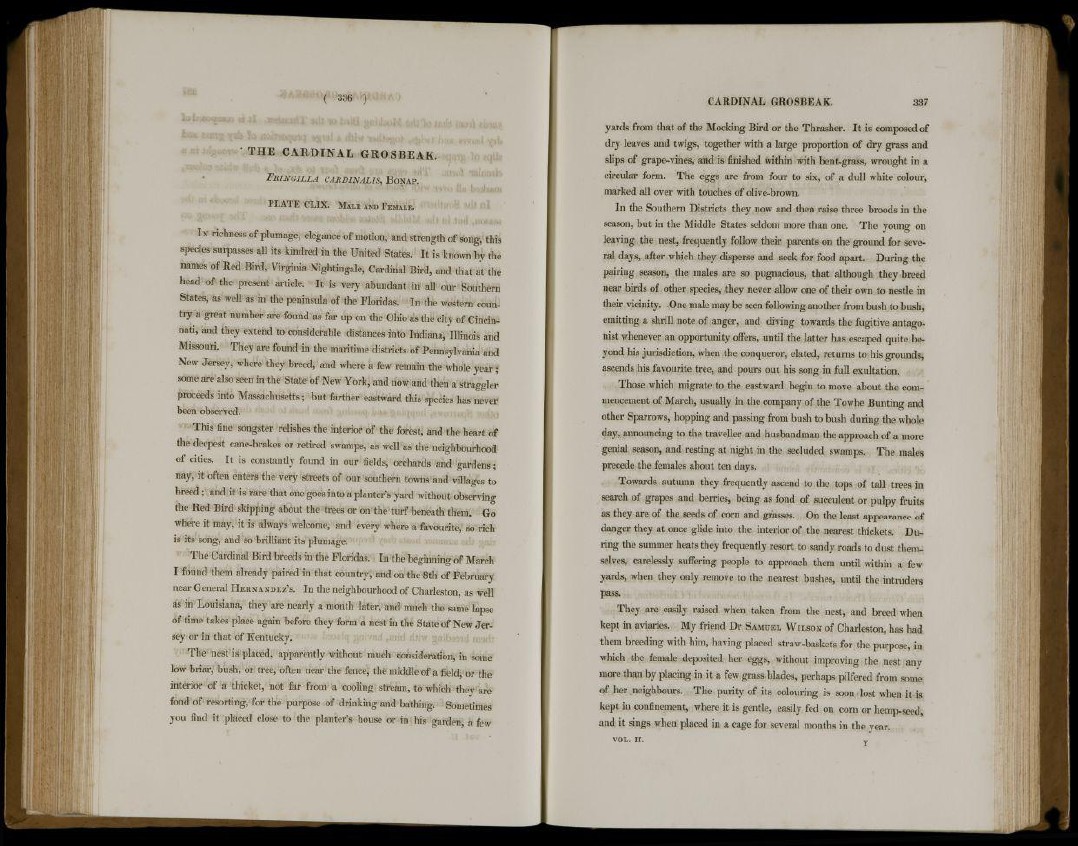
( 336 )
THE CARDINAL GROSBEAK.
FRINGILLA CARDINALIS, BONAP.
P L A T E C L I X . MALE AND FEMALE.
I N richness of plumage, elegance of motion, and strength of song, this
species surpasses all its kindred in the United States. It is known by the
names of Red Bird, Virginia Nightingale, Cardinal Bird, and that at the
head of the present article. It is very abundant in all our Southern
States, as well as in the peninsula of the Floridas. In the western country
a great number are found as far up on the Ohio as the city of Cincinnati,
and they extend to considerable distances into Indiana, Illinois and
Missouri. They are found in the maritime districts of Pennsylvania and
New Jersey, where they breed, and where a few remain the whole year;
some are also seen in the State of New York, and now and then a straggler
proceeds into Massachusetts; but farther eastward this species has never
been observed.
This fine songster relishes the interior of the forest, and the heart of
the deepest cane-brakes or retired swamps, as well as the neighbourhood
of cities. It is constantly found in our fields, orchards and gardens;
nay, it often enters the very streets of our southern towns and villages to
breed ; and it is rare that one goes into a planter's yard without observing
the Red Bird skipping about the trees or on the turf beneath them. Go
where it may, it is always welcome, and every where a favourite, so rich
is its song, and so brilliant its plumage.
The Cardinal Bird breeds in the Floridas. In the beginning of March
I found them already paired in that country, and on the 8th of February
near General HERNANDEZ'S. In the neighbourhood of Charleston, as well
as in Louisiana, they are nearly a month later, and much the same lapse
of time takes place again before they form a nest in the State of New Jersey
or in that of Kentucky.
The nest is placed, apparently without much consideration, in some
low briar, hush, or tree, often near the fence, the middle of a field, or the
interior of a thicket, not far from a cooling stream, to which they are
fond of resorting, for the purpose of drinking and bathing. Sometimes
you find it placed close to the planter's house or in his garden, a few
CARDINAL GROSBEAK 337
yards from that of the Mocking Bird or the Thrasher. It is composed of
dry leaves and twigs, together with a large proportion of dry grass and
slips of grape-vines, and is finished within with bent-grass, wrought in a
circular form. The eggs are from four to six, of a dull white colour,
marked all over with touches of olive-brown.
In the Southern Districts they now and then raise three broods in the
season, but in the Middle States seldom more than one. The young on
leaving the nest, frequently follow their parents on the ground for several
days, after which they disperse and seek for food apart. During the
pairing season, the males are so pugnacious, that although they breed
near birds of other species, they never allow one of their own to nestle in
their vicinity. One male may be seen following another from bush to bush,
emitting a shrill note of anger, and diving towards the fugitive antagonist
whenever an opportunity offers, until the latter has escaped quite beyond
his jurisdiction, when the conqueror, elated, returns to his grounds,
ascends his favourite tree, and pours out his song in full exultation.
Those which migrate to the eastward begin to move about the commencement
of March, usually in the company of the Towhe Bunting and
other Sparrows, hopping and passing from bush to bush during the whole
day, announcing to the traveller and husbandman the approach of a more
genial season, and resting at night in the secluded swamps. The males
precede the females about ten days.
Towards autumn they frequently ascend to the tops of tall trees in
search of grapes and berries, being as fond of succulent or pulpy fruits
as they are of the seeds of corn and grasses. On the least appearance of
danger they at once glide into the interior of the nearest thickets. During
the summer heats they frequently resort to sandy roads to dust themselves,
carelessly suffering people to approach them until within a few
yards, when they only remove to the nearest bushes, until the intruders
pass.
They are easily raised when taken from the nest, and breed when
kept in aviaries. My friend Dr SAMUEL WILSON of Charleston, has had
them breeding with him, having placed straw-baskets for the purpose, in
which the female deposited her eggs, without improving the nest any
more than by placing in it a few grass-blades, perhaps pilfered from some
of her neighbours. The purity of its colouring is soon lost when it is
kept in confinement, where it is gentle, easily fed on corn or hemp-seed,
and it sings when placed in a cage for several months in the year.
VOL. II. v